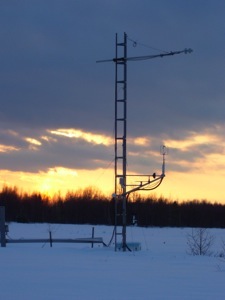Carbon and energy fluxes at the Mer Bleue bog
Peatlands are wetlands that have accumulated at least 30-40 cm of partially decomposed organic  material. Carbon accumulates due to a small imbalance between plant production and decomposition. Although northern peatlands occupy only 3% of the land surface, the C stored within this peat makes up about one-third of the total global soil C pool.
material. Carbon accumulates due to a small imbalance between plant production and decomposition. Although northern peatlands occupy only 3% of the land surface, the C stored within this peat makes up about one-third of the total global soil C pool.
We are making continuous measurements of CO2, energy and water fluxes at Mer Bleue, a low shrub ombrotrophic bog just outside Ottawa, Ontario. This long-term dataset is being used to shed light on the response of peatland C cycling to variations in weather and to help us understand how the C sink strength may change with climate warming. Measurements began in 1998 originally as part of the Peatland Carbon Study (PCARS). The measurements were continued as part of the Fluxnet Canada Research Network and the Canadian Carbon Project. Past data is available here.
Selected Publications:
- Granath G, Rydin H, Baltzer JL, Bengtsson F, Boncek N, Bragazza L, Bu Z-J, Caporn SJM, Dorrepaal E, Galanina O, Gałka M, Ganeva A, Gillikin DP, Goia I, Goncharova N, Hájek M, Haraguchi A, Harris LI, Humphreys E, Jiroušek M, Kajukało K, Karofeld E, Koronatova NG, Kosykh NP, Lamentowicz M, Lapshina E, Limpens J, Linkosalmi M, Ma J-Z, Mauritz M, Munir TM, Natali SM, Natcheva R, Noskova M, Payne RJ, Pilkington K, Robinson S, Robroek BJM, Rochefort L, Singer D, Stenøien HK, Tuittila E-S, Vellak K, Verheyden A, Waddington JM, Rice SK. 2018. Environmental and taxonomic controls of carbon and oxygen stable isotope composition in Sphagnum across broad climatic and geographic ranges. Biogeosciences, 15, 5189-5202, doi.org/10.5194/bg-15-5189-2018.
- Gianluca F, Cremonese E, Migliavacca M, Galvagno M, Sonnentag O, Humphreys E, Hufkense K, Ryu Y, Verfaillie J, Morra di Cella U, Richardson AD. 2018. NDVI derived from near-infrared-enabled digital cameras: applicability across different plant functional types. Agricultural and Forest Meteorology, 249: 275-285.
- Juutinen S, Moore T, Bubier J, Arnkill S, Humphreys E, Marincak B, Roy C, Larmola T. 2018. Long-term nutrient addition increased CH4 emission from a bog through direct and indirect effects. Nature Scientific Reports, 8, 3838, doi:10.1038/s41598-018-22210-2
- Kalacska M, Arroyo-Mora J, Soffer RJ, Roulet NT, Moore TR, Humphreys E, Leblanc G, Lucanus O, Inamdar D. 2018. Estimating peatland water table depth and net ecosystem exchange: a comparison between satellite and airborne imagery. Remote Sensing, 10, 687; doi:10.3390/rs10050687
- Qiu C et al. 2018. ORCHIDEE-PEAT (revision 4596), a model for northern peatland CO₂, water and energy fluxes on daily to annual scales. 2018. Geoscientific Model Development, 11, 497-519.
- Petrescu, A.M.R., Lohila, A., Tuovinen, J.-P. et al. 2015. The uncertain climate footprint of wetlands under human pressure, PNAS. doi/10.1073/pnas.1416267112
- Brown, M. G., E. R. Humphreys, T. R. Moore, N. T. Roulet, and P. M. Lafleur. 2014. Evidence for a nonmonotonic relationship between ecosystem-scale peatland methane emissions and water table depth, J. Geophys. Res. Biogeosci., 119, doi:10.1002/2013JG002576.
- Humphreys, E.R., Brown, M., Charron, C., and Jones, R. 2014. Contrasting the CO2 fluxes of a temperate ombrotrophic bog with fluxes from two bogs in the Canadian Hudson Bay Lowland. Arctic Antarctic Alpine Res. 46(1):103-113.
- Kross, A. S. E., N. T. Roulet, T. R. Moore, P. M. Lafleur, E. R. Humphreys, J. W. Seaquist, L. B. Flanagan, and M. Aurela. 2014. Phenology and its role in carbon dioxide exchange processes in northern peatlands, J. Geophys. Res. Biogeosci., 119, 1370–1384, doi:10.1002/ 2014JG002666.
- Kopp, B. J., Fleckenstein, J. H., Roulet, N. T., Humphreys, E., Talbot, J., and Blodau, C. 2013. Impact of long-term drainage on summer groundwater flow patterns in the Mer Bleue peatland, Ontario, Canada, Hydrol. Earth Syst. Sci., 17, 3485-3498, doi:10.5194/hess-17-3485-2013.
- Larmola, T., Bubier, J.L., Kobyljanec, C., Basiliko, N., Juutinen, S., Humphreys, E., Preston, M., and Moore, T.R. 2013. Vegetation feedbacks of nutrient addition lead to a weaker carbon sink in an ombrotrophic bog. Global Change Biology, 19, 3729–3739, doi: 10.1111/gcb.12328
- Brümmer, C., Black, T.A., Jassal, R.S., Grant, N.J., Spittlehouse, D.L., Chen, B., Nesic, Z., Amiro, B.D., Arain, M.A., Barr, A.G., Bourque, C.P.-A., Coursolle, C., Dunn, A.L., Flanagan, L.B., Humphreys, E.R., Lafleur, P.M., Margolis, H.A., McCaughey, J.H., and Wofsy, S.C. 2012. How climate and vegetation type influence evapotranspiration and water use efficiency in Canadian forest, peatland and grassland ecosystems, Agricultural and Forest Meteorology, 153: 14-30.
- Chong, M., Humphreys, E.R., and Moore, T.R. 2012. Microclimatic response to increasing shrub cover and its effect on Sphagnum CO2 exchange in a bog. Ecoscience, 19: 89-97.
- Knox, S.H., Carey, S.K., and Humphreys, E.R. 2012. Snow surface energy exchanges and snowmelt in a shrub-covered bog in eastern Ontario, Canada. Hydrological Processes, doi: 10.1002/hyp.9289
- Lai, D.Y.F., Roulet, N.T., Humphreys, E.R., Moore, T.R., and Dalva, M. 2012. The effect of atmospheric turbulence and chamber deployment period on autochamber CO2 and CH4 flux measurements in an ombrotrophic peatland. Biogeosciences, 9: 3305-3322.
- Schaefer, K and 50 others. 2012. A model-data comparison of gross primary productivity: Results from the North American Carbon Program site synthesis. Journal of Geophysical Research, 117, doi: 10.1029/2012JG001960.
- Wu, J., N. T. Roulet, M. Nilsson, P. Lafleur, and Humphreys, E. 2012. Simulating the Carbon Cycling of Northern Peatlands Using a Land Surface Scheme Coupled to a Wetland Carbon Model (CLASS3W-MWM), Atmosphere-Ocean, 50: 487-506.